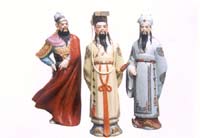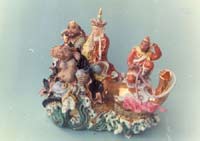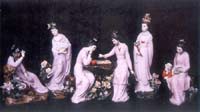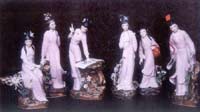|
Ceramic Culture and Literature
Ceramics and literature are different forms of art. The former is space-related art, while the latter is chronological art; the former is plastic art, while the latter is language-based art. The difference between the two makes them learn from each other, while their sameness is helpful for people to understand the artistic characteristics and for the artists to be stricter with themselves to produce images of prominent individualities and characters.
 We could not find textual records of the exact time when the close relationship between ceramic art and literature began. Though what I want to state is that it was extremely ancient. There is a quite similar point between the two: literature originates from labor and spontaneous oral accounts, is highly representative, and thus the contents of literature and labor are closely related to each other. A great amount of this kind of works can be found in "The Odes", the earliest complete collection of poems in China. We should never despite the representational literary works as being lack of artistic and aesthetic values. We could not find textual records of the exact time when the close relationship between ceramic art and literature began. Though what I want to state is that it was extremely ancient. There is a quite similar point between the two: literature originates from labor and spontaneous oral accounts, is highly representative, and thus the contents of literature and labor are closely related to each other. A great amount of this kind of works can be found in "The Odes", the earliest complete collection of poems in China. We should never despite the representational literary works as being lack of artistic and aesthetic values.
 Ceramic sculptures developed from a stage of naturalism. Those earthen animals are verisimilar to the real ones and represent the real life our ancestors. We can never deny the aesthetic values and significances of the naturalistic earthen sculptures, as can we never deny those of the primitive literature. Furthermore, representing an important early stage of the human civilization, their simplicity and na?veness are the qualities of modern ceramic art, which inspire modern ceramic artists. Ceramic sculptures developed from a stage of naturalism. Those earthen animals are verisimilar to the real ones and represent the real life our ancestors. We can never deny the aesthetic values and significances of the naturalistic earthen sculptures, as can we never deny those of the primitive literature. Furthermore, representing an important early stage of the human civilization, their simplicity and na?veness are the qualities of modern ceramic art, which inspire modern ceramic artists.
 Though being different forms of art, ceramic sculpture and literature agree with each other in their aesthetic nature: they reflect the life of the people and meet their aesthetic needs by molding figures. Though being different forms of art, ceramic sculpture and literature agree with each other in their aesthetic nature: they reflect the life of the people and meet their aesthetic needs by molding figures.
Jingdezhen is irrefutably a city of ceramics with a history of a thousand years. However, the local ceramic artists have made Jingdezhen become a city of literature through their skillful hands with clay and fire. They wonderfully express the furious war flames in "The Three Kingdoms", the flying righteous flags in "The Outlaws of the Marsh", the long and tough journey in "The Journey to the West", the vicissitudes of life in "A Dream in Red Mansions"; the elegies by Qu Yuan, the boldness and unconstrainedness of Li Bai, the dire straits of Du Fu, the broad-mindedness of Su Dongpo;  Goddess Nuwa who created man, the lonely Chang'e, Meng Jiangnu crying for her husband buried beneath the Great Wall, Liang Shanbo and Zhu Yingtai whose love transcends mortal life, the Vega in tears, loving Cui Yingying and Du Liniang, and Du Shiniang who was driven to prostitution; the extremely arrogant Emperor Qin Shihuang, the complacent Han emperor Liu Bang, the valorous Chu King Xiang Yu besieged on all sides, the Tang emperor Li Shimin of great talent and bold vision; the forwarding warriors with daggers in their hands, the young performers who play Xiao (a traditional Chinese wind instrument), and the mothers yearning for their sons coming back home. In short, coming out of the literary works, the various figures play numerous touching dramas. The ceramic artists from the ceramic capital have created a literary kingdom of ceramic art. Goddess Nuwa who created man, the lonely Chang'e, Meng Jiangnu crying for her husband buried beneath the Great Wall, Liang Shanbo and Zhu Yingtai whose love transcends mortal life, the Vega in tears, loving Cui Yingying and Du Liniang, and Du Shiniang who was driven to prostitution; the extremely arrogant Emperor Qin Shihuang, the complacent Han emperor Liu Bang, the valorous Chu King Xiang Yu besieged on all sides, the Tang emperor Li Shimin of great talent and bold vision; the forwarding warriors with daggers in their hands, the young performers who play Xiao (a traditional Chinese wind instrument), and the mothers yearning for their sons coming back home. In short, coming out of the literary works, the various figures play numerous touching dramas. The ceramic artists from the ceramic capital have created a literary kingdom of ceramic art.
 Literature offers fodders for ceramic art and inspires its modeling of figures. Modeling figures of ceramic art is not copying those in literature works, but creating highly abstract ones based on the literary works, which shows their excellent techniques and aesthetic power. Literature is a form of chronological art, while as plastic art, sculpture is touchable and picturing. Literature is apt to story telling and depicting the whole process of the beginning and development of the figures, while ceramic sculptures represent transience which can only tell people "what" rather than "why". It is not an easy task to model figures from literary works, especially those sculptures in a large group. Literature offers fodders for ceramic art and inspires its modeling of figures. Modeling figures of ceramic art is not copying those in literature works, but creating highly abstract ones based on the literary works, which shows their excellent techniques and aesthetic power. Literature is a form of chronological art, while as plastic art, sculpture is touchable and picturing. Literature is apt to story telling and depicting the whole process of the beginning and development of the figures, while ceramic sculptures represent transience which can only tell people "what" rather than "why". It is not an easy task to model figures from literary works, especially those sculptures in a large group.
However, the ceramic artists succeed in modeling both a singular figure and group sculptures. Zeng Shandong's "The Monkey Deity Sun Wukong Fighting the Various Gods", Li Gongkun's "The Three Kingdoms" are typically modeled after the literary works. Worth mentioning, the large-scaled group sculptures based on "The One Hundred and Eight Warriors in 'The Outlaws of the Marsh'" is a highly successful work.
All who have read the chapter of "The One Hundred and Eight Warriors" from "The Outlaws of the Marsh" know that the backgrounds and experiences of the warriors-families, professions, personalities, education, and the reasons why they were driven to Mount Liangshan-are quite different. Jin Shengtan's comment-"every one of them has his own personalities, his own temperament, his own appearance, and his own voice"-is reliable.
Though it is not easy to represent these figures-whom every Chinese knows very well-in ceramic sculpturing. Mr. Xiong Gangru once said, "a process of difficult remodeling exists in building up embodied figures of literary concepts, which requires the artist perfectly represent, through ceramic sculpting techniques, the description of the figures in the novel and embody the imaginative artistic figures into visual ones which bridges the feelings of the audience and the visual figures."
Thanks to the excellent arts and crafts and congregated artists, this successful group sculpture is formed through composing the sketches independently, determining them by groups, sculpting independently and revising by groups. Using various techniques: round sculpting, hand-pinching, open-work carving, clay applique, and other traditional ones from Jingdezhen, it has strong local characteristics of the ceramic sculpture from the city. Of diverse appearances and personalities, the warriors faithfully represent those in the novel.
In the article "A Vivid Representation of the Figures in 'The Outlaws of the Marsh'-the Ceramic Sculpture of the One Hundred and Eight Warriors", Mr. Xiong Gangru and Mr. Ding Ping comment "Diverse in their facial expressions and characterized in their unique compositions, the one hundred and eight warriors are reserved but interesting, or frank and outward. Their top leader Hubaoyi Song Jiang has beautiful triangular eyes, lying silkworm-shaped brows, a broad forehead and round cheeks, well-shaped lips and a just mouth, and is soberly sitting in his dragon throne with the command flag in his hands. In this way he is presented as a general with firmness and sobriety, impressive manners, and generosity 'to benefit thousands of people'. With 'firm eyebrows and shining eyes', the second top leader Lu Junyi is stately standing holding the commanding flag and his long sword. The heads-up brainman Wu Yong is modeled after Zhu Geliang-with white countenance and a good-looking beard, beautiful eyes and brows, contemplating when strolling in a Confucian robe and swagging his feather fan. In a Taoist crane feather robe, with his face upward and hair dishevelled, eyes closed and lips pouted, his ancient sword upward to the sky, Gongsun Sheng seems to be idiotic but fascinating and semi-godly. The scenes of controlling the forces of nature and blowing clouds, and especially the hot tempers of glowering Qin Ming are perfectly depicted. This group of sculptures is like a painting of the rotating clouds and pouring ink, which is vigorous and magnificent. "
Ceramic Culture and Calligraphy
Ceramic Culture and Philosophy
|

